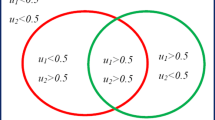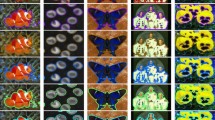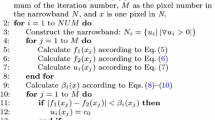Abstract
Segmentation of real images having unwanted outliers, inhomogeneity or complex background is always very challenging for active contour models. In this paper, we propose a novel model for segmentation of such type of images. The proposed model is based on fuzzy energy functional, which uses coefficient of variation as a region statistics. The proposed model is convex due to introduction of fuzzy membership functions in the energy functional and hence converges to the absolute minima and avoids local minima. Convexity of the proposed model is proved, and hence, the model is independent of initial placement of the contour. Experimental results of the proposed model are compared with other state-of-the-art existing models both qualitatively and quantitatively. For quantitative comparison, we have used Jaccard similarity index and computational complexity. The proposed model is tested on various data sets containing noisy images, images having intensity inhomogeneity and slight texture. In all experimental results, performance of the proposed model can be seen in the experimental section.









Similar content being viewed by others
References
Ali H, Badshah N, Chen K, Khan GA (2016) A variational model with hybrid images data fitting energies for segmentation of images with intensity inhomogeneity. Pattern Recognit 51:27–42
Appleton B, Talbot H (2005) Globally optimal geodesic active contours. J Math Imaging Vis 23(1):67–86
Aubert G, Kornprobst P (2006) Mathematical problems in image processing: partial differential equations and the calculus of variations. Springer, New York
Badshah N, Chen K, Ali H, Murtaza G (2012) A coefficient of variation based image selective segmentation model using active contours. East Asian J Appl Math 2(2):150–169
Balla-Arab S, Gao X, Wang B (2013) A fast and robust level set method for image segmentation using fuzzy clustering and lattice Boltzmann method. IEEE Trans Cybern 43(3):910–920
Caselles V, Catte F, Coll T, Dibos F (1993) A geometric model for active contours in image processing. Numer Math 66(1):1–31
Caselles V, Kimmel R, Sapiro G (1997) Geodesic active contours. Int J Comput Vis 22(1):61–79
Chan TF, Vese LA (2001) Active contours without edges. IEEE Trans Image Process 10(2):266–277
Chan TF, Esedoglu S, Nikolova M (2006) Algorithms for finding global minimizers of image segmentation and denoising models. SIAM J Appl Math 66(5):1632–1648
Esedoglu S, Tsai R (2005) Threshold dynamics for the piecewise constant Mumford–Shah functional. J Comput Phys 211(1):367–384
Jaccard P (1901) Distribution de la flore alpine dans le bassin des Dranses et dans quelques rgions voisines. Bulletin de la Socit Vaudoise des Sciences Naturelles 37:241–272
Kass M, Witkin A, Terzopoulos D (1988) Snakes: active contour models. Int J Comput Vis 1(4):321–331
Kichenassamy S, Kumar A, Olver P, Tannenbaum A, Yezzi A (1996) Conformal curvature flows: from phase transitions to active vision. Arch Ration Mech Anal 134(3):275–301
Krinidis S, Chatzis V (2009) Fuzzy energy-based active contours. IEEE Trans Image Process 18(12):2747–2755
Krinidis S, Chatzis V (2010) A robust fuzzy local information c-means clustering algorithm. IEEE Trans Image Process 19(5):1328–1337
Lankton S, Tannenbaum A (2008) Localizing region-based active contours. IEEE Trans Image Process 17(11):2029–2039
Lee S, Seo JK (2006) Level set-based bimodal segmentation with stationary global minimum. IEEE Trans Image Process 15:2843–2852
Li Y, Feng X (2016) A multiscale image segmentation method. Pattern Recognit 52:332–345
Li C, Xu C, Gui C, Fox MD (2005) Level set evolution without re-initialization: a new variational formulation. In: Proceedings of IEEE conference on computer vision and pattern recognition (CVPR), vol 1, pp 430–436
Li C, Kao CY, Gore JC, Ding Z (2008) Minimization of region-scalable fitting energy for image segmentation. IEEE Trans Image Process 17(10):1940–1949
Lie J, Lysaker M, Tai XC (2006) A binary level set model and some applications for Mumford–Shah image segmentation. IEEE Trans Image Process 15(4):1171–1181
Lin TY, Maire M, Belongie S, Hays J, Perona P, Ramanan D, Dollar P, Zitnick CL (2014) Microsoft COCO: common objects in context. In: Proceedings of European conference on computer vision, pp 740–755
Liu Z, Guo B (2006) New numerical algorithms for the nonlinear diffusion model of image denoising and segmentation. Appl Math Comput 11(2):380–389
Malladi R, Sethian JA, Vemuri BC (1993) Topology-independent shape modeling scheme. In: SPIE’s 1993 international symposium on optics, imaging, and instrumentation. International Society for Optics and Photonics, pp 246–258
Martin D, Fowlkes C, Tal D, Malik J (2001) A database of human segmented natural images and its application to evaluating segmentation algorithms and measuring ecological statistics. In: Proceedings of the computer vision. ICCV 2001. Eighth IEEE international conference on IEEE, vol 2, pp 416–423
Mena JB, Malpica JA (2005) Color image segmentation based on three levels of texture statistical evaluation. Appl Math Comput 161(1):1–17
Mikula K, Sgallari F (2003) Semi-implicit finite volume scheme for image processing in 3D cylindrical geometry. J Comput Appl Math 161(1):119–132
Mondal A, Ghosh S, Ghosh A (2016) Robust global and local fuzzy energy based active contour for image segmentation. Appl Soft Comput 47:191–215
Mora M, Tauber C, Batatia H (2005) Robust level set for heart cavities detection in ultrasound images. Comput Cardiol 32:235–238
Morel JM, Solimini S (2012) Variational methods in image segmentation: with seven image processing experiments. Springer, New York
Mumford D, Shah J (1989) Optimal approximation by piecewise smooth functions and associated variational problems. Commun Pure Appl Math 42(5):577–685
Nayak J, Naik B, Behera HS (2015) Fuzzy C-means (FCM) clustering algorithm: a decade review from 2000 to 2014. Comput Intell Data Min 2:133–149
Osher S, Sethian JA (1988) Fronts propagating with curvature-dependent speed: algorithms based on Hamilton–Jacobi formulations. J Comput Phys 79(1):12–49
Paragios N, Deriche R (2000) Geodesic active contours and level sets for the detection and tracking of moving objects. IEEE Trans Pattern Anal Mach Intell 22(3):266–280
Paragios N, Chen Y, Faugeras O (2005) Handbook of mathematical models in computer vision. Secaucus
Patra S, Gautam R, Singla A (2014) A novel context sensitive multilevel thresholding for image segmentation. Appl Soft Comput 23(12):2–127
Sethian JA (1999) Level set methods and fast marching methods evolving interfaces in computational geometry. Fluid mechanics, computer vision, and materials science. Cambridge University Press, Cambridge
Song B, Chan T (2002) A fast algorithm for level set based optimization. UCLA CamReport 2(68)
Vese LA, Chan TF (2002) A multiphase level set framework for image segmentation using the Mumford and Shah model. Int J Comput Vis 50(3):271–293
Wang XF, Huang DS, Xu H (2010) An efficient local Chan–Vese model for image segmentation. Pattern Recognit 43(3):603–618
Wang XF, Min H, Zhang YG (2015) Multi-scale local region based level set method for image segmentation in the presence of intensity inhomogeneity. Neurocomputing 151:1086–1098
Wu Y, He C (2015) A convex variational level set model for image segmentation. Sig Process 106:123–133
Wu Y, Ma W, Gong M, Li H, Jiao L (2015) Novel fuzzy active contour model with kernel metric for image segmentation. Appl Soft Comput 34:301–311
Yezzi A, Kichenassamy S, Kumar A, Olver P, Tannenbaum A (1997) A geometric snake model for segmentation of medical imagery. IEEE Trans Med Imaging 16(2):199–209
Zadeh LA (1965) Fuzzy sets. Inf Control 8(3):338–353
Zhang T, Freedman D (2003) Tracking objects using density matching and shape priors. In: Proceedings ninth IEEE international conference on computer vision, pp 1056–1062
Zhang KH, Song HH, Zhang L (2010) Active contours driven by local image fitting energy. Pattern Recognit 43(4):1199–1206
Author information
Authors and Affiliations
Corresponding author
Ethics declarations
Conflict of interest
The authors declare that they have no conflict of interest.
Ethical approval
This article does not contain any studies with human participants or animals performed by any of the authors.
Additional information
Communicated by V. Loia.
Publisher's Note
Springer Nature remains neutral with regard to jurisdictional claims in published maps and institutional affiliations.
Rights and permissions
About this article
Cite this article
Ahmad, A., Badshah, N. & Ali, H. A fuzzy variational model for segmentation of images having intensity inhomogeneity and slight texture. Soft Comput 24, 15491–15506 (2020). https://doi.org/10.1007/s00500-020-04878-9
Published:
Issue Date:
DOI: https://doi.org/10.1007/s00500-020-04878-9




